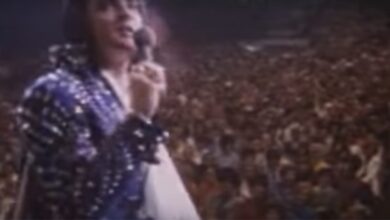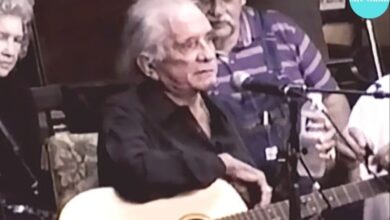This Popular Dance from the 1950s, Do You Remember It Today
In February 1958, a dance craze exploded across American high school gyms and sock hops, capturing the vibrant spirit of the era and embodying the carefree energy of rock ‘n’ roll’s early days. This dance was “The Stroll,” a line dance that quickly became synonymous with youthful fun and spontaneity. It originated in African American communities but gained widespread popularity through television, particularly on Dick Clark’s “American Bandstand,” where teenagers nationwide saw and eagerly adopted the dance at local gatherings. The Stroll served not only as a form of entertainment but also as a means of social interaction, fostering a sense of community among young people.
The dance was characterized by its infectious rhythm, drawing on popular music styles of the time, particularly doo-wop. The Stroll involved two lines of participants facing each other, creating an aisle down the middle. Couples would take turns strutting down this aisle in rhythm with the music, adding personal flair to their movements. This format allowed for both group participation and individual expression, resonating deeply with youth who were starting to assert their identities within a rapidly changing society. The simple yet engaging steps made it easy for anyone to join in, no matter their dancing skill level, which contributed to its widespread appeal.
Accompanying this dance was the song “The Stroll,” performed by the Canadian vocal group The Diamonds. Known for their smooth harmonies and catchy doo-wop tunes, The Diamonds played a crucial role in bringing “The Stroll” to a broader audience. Their version of “The Stroll” became an anthem, encapsulating the joy of the dance and serving as a backdrop for countless social gatherings. The group’s lead singer, Dave Somerville, with his rich baritone voice, became the voice of the dance craze, guiding dancers with his melodic crooning. The infectious nature of the song, combined with the visual spectacle of the dance, created a dynamic pairing that was hard to resist.
The uptake of The Stroll extended beyond just music and dance; it became a pivotal aspect of youth culture. The simplicity of the choreography meant that anyone could participate, regardless of background, fostering a sense of unity among adolescents. This was particularly significant in a time marked by social segregation and racial tensions. The cross-cultural interactions facilitated by The Stroll allowed young people from diverse backgrounds to come together in celebration of music and dance, paving the way for further integration in social settings.
As “The Stroll” surged in popularity, it became emblematic of a generation’s desire to express themselves and enjoy the newfound freedoms of the 1950s. Teenagers, inspired by the rebellious spirit of rock ‘n’ roll, flocked to dance floors in their best outfits, eager to take part in the latest trend and exude a confidence that mirrored the optimism of post-war America. The Stroll was not just a dance; it was a declaration of independence and a celebration of youth culture.
The cultural impact of The Stroll extended well beyond the dance floors and sock hops. It influenced fashion, with styles from the 1950s becoming closely associated with the carefree vibe of the dance. Teenagers began to adopt bolder styles, often showcasing brightly colored outfits that matched the lively tunes playing at dances. Haircuts and accessory choices also reflected the spirit of the era, as young people embraced individuality and self-expression.
Moreover, the media played an instrumental role in the popularization of The Stroll. Shows like “American Bandstand” provided a platform for various artists and dancers, showcasing the vibrancy of youth culture. This exposure helped solidify the dance’s place in American pop culture, making it a memorable part of the era’s social fabric. The Stroll resonated with viewers, inspiring them to join in and celebrate life through music and dance, thereby amplifying its popularity.
The legacy of The Stroll endures as a symbol of a time when music and dance were powerful forces for unity and joy. It represents a moment in American history where young people began to carve out their identities, engaging with cultural movements that transcended existing societal norms. The Stroll is often reminisced about in documentaries and retrospectives celebrating the 1950s, underscoring its significance in shaping the evolving landscape of American youth culture.
In the years that followed, the simplicity and charm of The Stroll influenced subsequent dance crazes, leaving an indelible mark on the landscape of American music and youth culture. Many dances borrowed elements from The Stroll, adapting them to create new fads that would capture the hearts of successive generations. This lineage of dance, rooted in community and shared joy, continues to be a part of the social fabric of America today.
Reflecting on the enduring appeal of The Stroll, it’s clear that it was more than just a fleeting dance craze; it was a cultural movement that brought people together across divisions. The magic of The Stroll lies in its ability to unite generations through shared experiences of rhythm and movement. Even today, remnants of its influence can be seen in modern dance styles and social gatherings, where rhythm serves as a universal language that bridges gaps between individuals. The Stroll encapsulates the vibrancy of youth and the power of music as a means of connection, a sentiment that resonates across time and space.
?si=CbHsPwTM-VodZAIG





